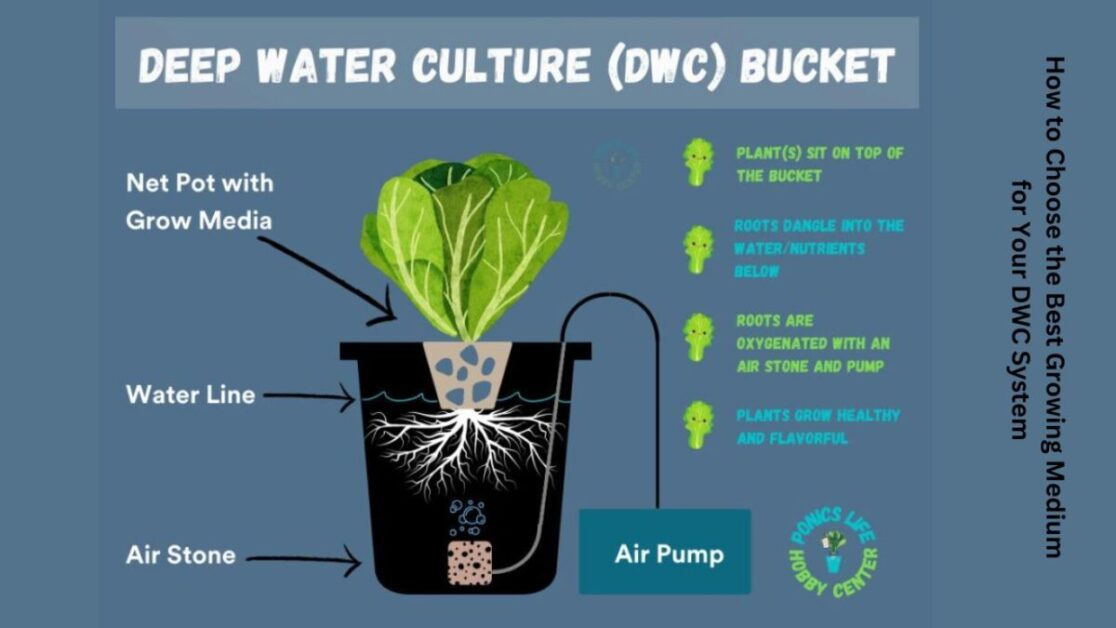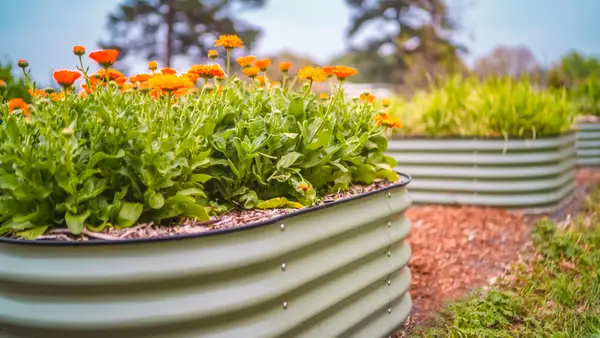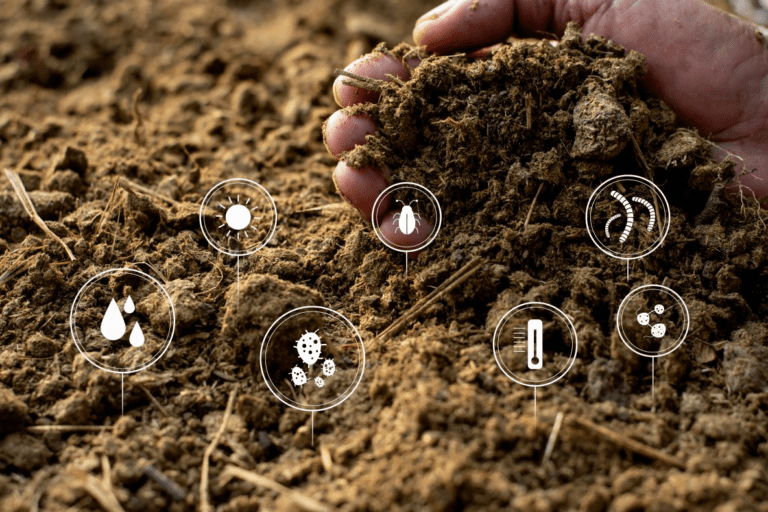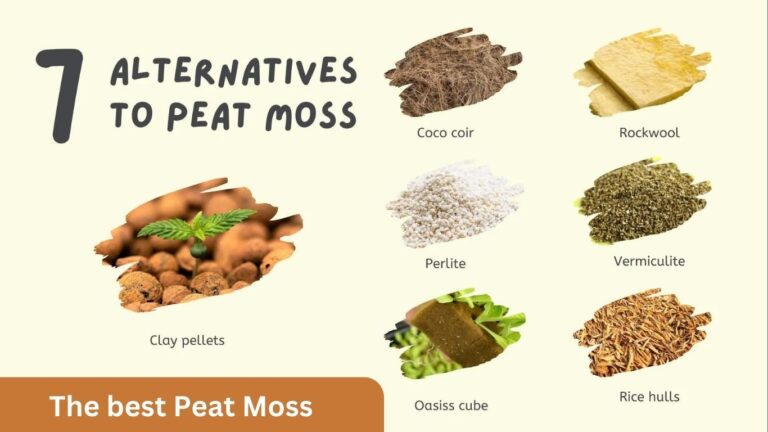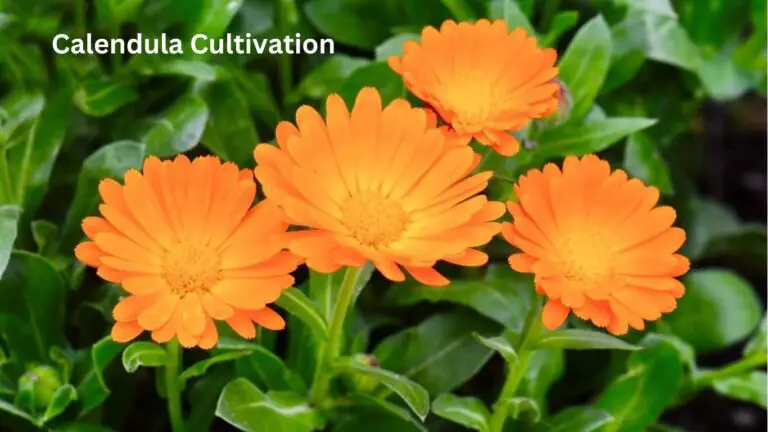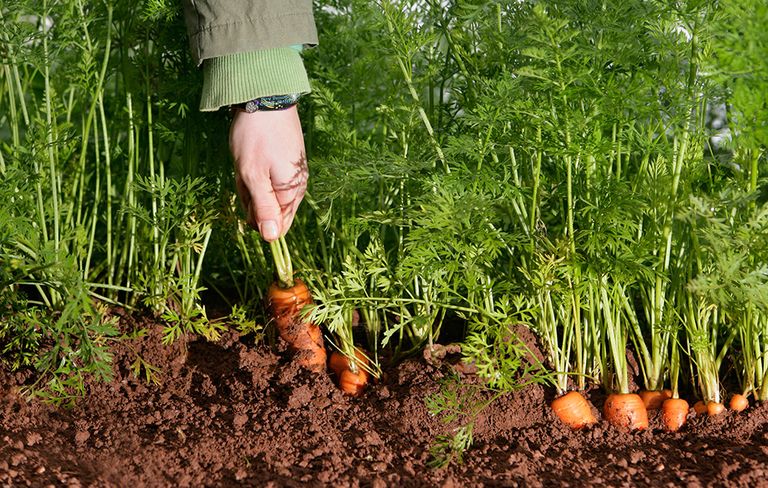DWC System: How to Choose the Best Growing Medium
Table of Contents DWC System
DWC System: How to Choose the Best Growing Medium
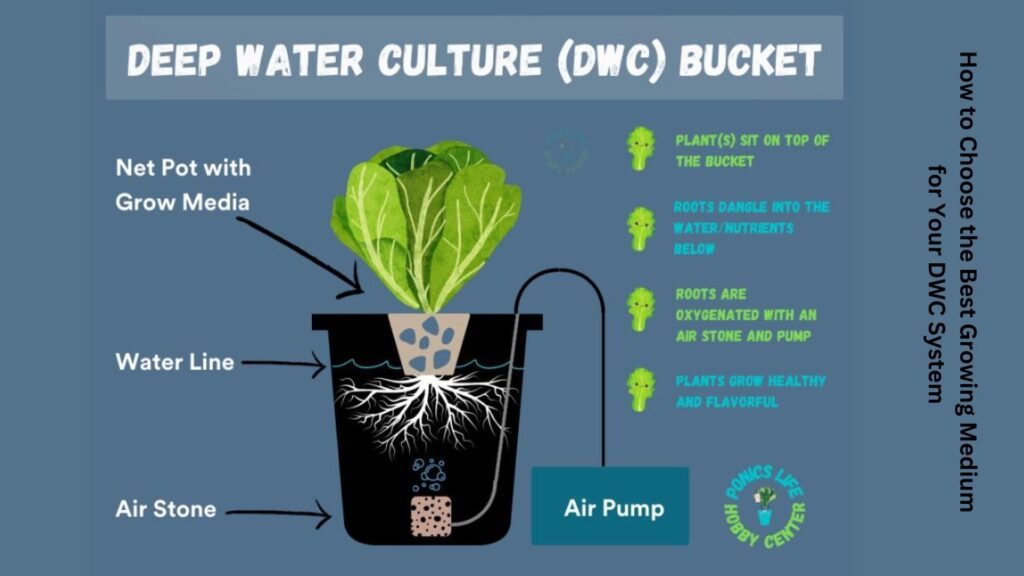
Understanding the importance of selecting the right growing medium is crucial when setting up a Deep Water Culture (DWC) system. The growing medium plays a vital role in providing stability and support for the plants’ roots, as well as facilitating the delivery of nutrients and oxygen. It is essential to consider several factors when choosing a growing medium for your DWC system to ensure optimal plant health and growth.
Firstly, one important consideration is the nutrient needs of your plants. Different plants require varying levels of nutrients, and certain growing mediums may be more suitable for specific nutrient requirements. Understanding the nutrient composition of the growing medium and its ability to retain and release essential elements is crucial in providing the right balance for your plants. By considering the nutrient needs of your plants, you can select a growing medium that promotes healthy and robust growth.
• Consider the nutrient needs of your plants
• Understand the nutrient composition and retention capabilities of the growing medium
• Select a growing medium that promotes healthy and robust growth
1) Understanding Deep Water Culture DWC System
Deep Water Culture (DWC) systems are a popular choice among hydroponic enthusiasts for their simplicity and effectiveness in promoting plant growth. In a DWC system, plants are suspended in a nutrient-rich solution with their roots exposed directly to the oxygenated water. This method ensures that plants receive an abundance of both nutrients and oxygen, leading to enhanced nutrient uptake and faster growth rates compared to traditional soil-based methods.
The key feature of a DWC system is the use of an airstone or diffuser, which constantly bubbles air through the water. This continuous flow of oxygen helps to prevent root rot and allows for the efficient absorption of nutrients by plant roots. Additionally, the deep water reservoir provides a stable environment for the plants, allowing for optimal growth conditions.
Overall, DWC systems offer several advantages for hydroponic gardening, including increased oxygenation, better nutrient absorption, and faster growth rates. These systems are also relatively low maintenance and can be easily scaled up or down depending on your needs. By understanding the fundamentals of DWC systems, you can make informed decisions when it comes to selecting the appropriate growing medium and optimizing your hydroponic setup for successful cultivation.
• DWC systems are popular among hydroponic enthusiasts for their simplicity and effectiveness in promoting plant growth.
• In a DWC system, plants are suspended in a nutrient-rich solution with their roots exposed directly to oxygenated water.
• This method ensures that plants receive an abundance of both nutrients and oxygen, leading to enhanced nutrient uptake and faster growth rates compared to traditional soil-based methods.
• The key feature of a DWC system is the use of an airstone or diffuser, which constantly bubbles air through the water.
• This continuous flow of oxygen helps prevent root rot and allows for efficient absorption of nutrients by plant roots.
• The deep water reservoir provides a stable environment for the plants, allowing for optimal growth conditions.
• Overall, DWC systems offer advantages such as increased oxygenation, better nutrient absorption, and faster growth rates.
• These systems are also relatively low maintenance and can be easily scaled up or down depending on your needs.
2) The Importance of Choosing the Right Growing Medium
Choosing the right growing medium for your Deep Water Culture (DWC) system is crucial to the success of your hydroponic garden. The growing medium serves as a support structure for the plants’ roots and acts as a reservoir for water and nutrients. It plays a significant role in nutrient uptake, water retention, aeration, and overall plant health.
The importance of selecting the appropriate growing medium lies in its ability to provide the ideal conditions for your plants to thrive. Different plants have varying nutrient requirements, and the growing medium you choose should be able to adequately supply these nutrients. Additionally, the pH levels of the growing medium directly affect nutrient availability, making it essential to consider this factor when making your selection. Moreover, each growing medium has unique water retention properties, affecting how much water is available to the roots, and the frequency of watering required. Furthermore, the aeration levels provided by the growing medium can impact root oxygenation, which is crucial for optimal growth. Lastly, the drainage capabilities of the medium should be considered to prevent waterlogged conditions that can lead to root rot or fungal diseases. By carefully evaluating these factors, you can ensure that your chosen growing medium meets the specific needs of your plants, fostering healthy and vigorous growth in your DWC system.
• The growing medium serves as a support structure for the plants’ roots and acts as a reservoir for water and nutrients.
• It plays a significant role in nutrient uptake, water retention, aeration, and overall plant health.
• Different plants have varying nutrient requirements, so it’s important to choose a growing medium that can adequately supply these nutrients.
• pH levels of the growing medium directly affect nutrient availability, making it essential to consider this factor when making your selection.
• Each growing medium has unique water retention properties that affect how much water is available to the roots and the frequency of watering required.
• The aeration levels provided by the growing medium can impact root oxygenation, which is crucial for optimal growth.
• Drainage capabilities of the medium should be considered to prevent waterlogged conditions that can lead to root rot or fungal diseases.
DWC System: Considerations for Your Plants’ Nutrient Needs
When selecting a growing medium for your DWC system, it is crucial to consider your plants’ nutrient needs. Different plants have varying requirements for essential nutrients such as nitrogen, phosphorus, and potassium, as well as micronutrients like iron, manganese, and zinc. Understanding the specific nutrient needs of your plants will help you choose a growing medium that can provide adequate nutrition.
One way to assess your plants’ nutrient needs is through soil or water testing. This will provide valuable information about the existing nutrient levels and any deficiencies or imbalances that need to be addressed. By knowing the precise nutrient requirements of your plants, you can select a growing medium that is capable of providing the necessary nutrients in an accessible form. Additionally, consider using a nutrient solution that is formulated specifically for hydroponic systems, as these solutions are designed to meet the nutritional needs of plants grown in water-based environments.
• Different plants have varying nutrient requirements
• Essential nutrients include nitrogen, phosphorus, and potassium
• Micronutrients like iron, manganese, and zinc are also important
• Soil or water testing can assess existing nutrient levels and deficiencies
• Choose a growing medium that can provide adequate nutrition based on plant needs
• Consider using a hydroponic-specific nutrient solution for optimal results
Evaluating the pH Requirements of Different Growing Media DWC System
The pH level of the growing medium plays a crucial role in the success of a deep water culture (DWC) system. Different plants have varying pH requirements, and it is essential to select a growing medium that aligns with these needs.
When evaluating the pH requirements of different growing media, it is important to consider their natural acidity or alkalinity. Some growing media, such as coco coir and peat moss, tend to be more acidic, while others like expanded clay pellets and perlite are generally more neutral. Rockwool, on the other hand, has a slightly alkaline pH. It is crucial to match the pH requirements of your plants with the pH range of the chosen growing medium to ensure optimal nutrient uptake and plant health. Regularly monitoring and adjusting the pH of the nutrient solution is also essential for maintaining the desired pH level within the DWC system.
• Coco coir and peat moss are more acidic growing media
• Expanded clay pellets and perlite are generally more neutral
• Rockwool has a slightly alkaline pH
• Matching the pH requirements of plants with the chosen growing medium is crucial for optimal nutrient uptake and plant health
• Regularly monitoring and adjusting the pH of the nutrient solution is essential for maintaining the desired pH level within a DWC system.
5) Examining the Water Retention Properties of Various Growing Mediums
Examining the water retention properties of various growing mediums is crucial when selecting the right one for your DWC (Deep Water Culture) system. The ability of a growing medium to hold and distribute water is essential for providing plants with the necessary moisture they need for optimal growth.
Coco coir, for example, is known for its excellent water retention capabilities. It can hold up to 10 times its weight in water, ensuring that your plants have a constant supply of moisture. This is particularly beneficial in dry climates or for plants with high water requirements.
On the other hand, expanded clay pellets have a lower water retention capacity. While they still retain some moisture, they are better known for their excellent drainage properties. This can be advantageous for plants that are more susceptible to root rot or for growers who prefer a drier root environment. However, it’s essential to monitor the water levels carefully to prevent underwatering.
Understanding the water retention properties of different growing mediums allows you to tailor your DWC system to the specific needs of your plants. Whether you prioritize moisture retention or prefer enhanced drainage, selecting the appropriate growing medium will play a vital role in achieving successful hydroponic cultivation.
• Coco coir has excellent water retention capabilities and can hold up to 10 times its weight in water.
• Expanded clay pellets have a lower water retention capacity but are known for their excellent drainage properties.
• Coco coir is beneficial for plants in dry climates or those with high water requirements.
• Expanded clay pellets are advantageous for plants susceptible to root rot or growers who prefer a drier root environment.
• Careful monitoring of water levels is necessary when using expanded clay pellets to prevent underwatering.
• Understanding the water retention properties of different growing mediums allows customization based on plant needs.
6) Assessing the Aeration Levels Provided by Different Growing Media
Assessing the aeration levels provided by different growing media is crucial in maintaining healthy plant roots and promoting optimal nutrient uptake in a Deep Water Culture (DWC) system. Adequate aeration ensures a sufficient oxygen supply to the roots, which is vital for proper respiration and overall plant growth.
When selecting a growing medium, it is important to consider its aeration capabilities. Some growing media, such as expanded clay pellets, have excellent aeration properties due to their porous nature. The air-filled spaces within these pellets allow for the free exchange of oxygen and carbon dioxide, facilitating healthy root development. Additionally, expanded clay pellets promote the circulation of water and nutrients, preventing waterlogging and root rot.
On the other hand, growing mediums like rockwool or peat moss may not provide as much aeration. These media have a higher water retention capacity, which can lead to reduced oxygen levels around the roots. Without sufficient aeration, plant roots may become susceptible to oxygen deficiency, leading to stunted growth, nutrient deficiencies, or even root diseases.
It is worth noting that different plant species have varying aeration requirements. For instance, plants with deeper root systems may require a growing medium that can provide enhanced oxygenation to reach the lower roots effectively. Furthermore, factors such as the size of the airstones or diffusers, the airflow rate, and the water level in the DWC system can all influence the aeration levels within the growing medium.
In conclusion, assessing the aeration levels provided by different growing media is vital for selecting the most suitable option for a DWC system. Choosing a medium with optimal aeration capabilities ensures the availability of oxygen to the roots, promoting healthy growth and nutrient uptake. By considering the specific needs of your plants and appropriately managing factors like water level and airflow, you can create an environment that fosters robust root development and overall plant vitality. Selecting the right growing medium capable of providing adequate aeration sets the foundation for a successful DWC system.
• Expanded clay pellets have excellent aeration properties due to their porous nature
• The air-filled spaces within expanded clay pellets allow for the free exchange of oxygen and carbon dioxide
• Expanded clay pellets promote water and nutrient circulation, preventing waterlogging and root rot
• Rockwool or peat moss may not provide as much aeration due to their higher water retention capacity
• Reduced oxygen levels around the roots can lead to stunted growth, nutrient deficiencies, or root diseases
• Different plant species have varying aeration requirements based on their root systems
• Factors such as airstone size, airflow rate, and water level in the DWC system can influence aeration levels
in growing media
7) Analyzing the Drainage Capabilities of Potential Growing Mediums
To ensure the success of your deep water culture (DWC) system, it is essential to select a growing medium that promotes proper drainage. The drainage capabilities of a potential growing medium will determine how effectively excess water is removed from the roots, preventing waterlogged conditions that can lead to root rot and other detrimental issues.
When analyzing the drainage capabilities of different growing mediums, it is important to consider their porosity and water-holding capacity. Porous materials allow excess water to drain away quickly, preventing the roots from becoming waterlogged. On the other hand, materials with high water-holding capacity may retain too much moisture, impeding proper drainage. Striking the right balance is crucial to maintain the ideal moisture level for your plants. Additionally, the texture and particle size of the growing medium can influence its drainage capabilities. Fine-grained materials tend to retain more water and drain slower, while coarser materials facilitate better drainage. Keep these factors in mind when selecting a growing medium, as they directly impact the well-being of your plants in a DWC system.
• Porosity and water-holding capacity are key factors in analyzing drainage capabilities of growing mediums
• Porous materials allow excess water to drain away quickly, preventing waterlogging and root rot
• Materials with high water-holding capacity may retain too much moisture, impeding proper drainage
• Striking the right balance is crucial for maintaining ideal moisture levels for plants
• Texture and particle size of the growing medium can also affect drainage capabilities
• Fine-grained materials tend to retain more water and drain slower
• Coarser materials facilitate better drainage
• Consider these factors when selecting a growing medium for a DWC system.
8) Exploring the Suitability of Organic vs. Inorganic Growing Mediums
Organic and inorganic growing mediums serve as the foundation for your DWC (Deep Water Culture) system, providing vital support and nutrients to your plants. Selecting the right growing medium is crucial to ensure optimal growth and yield.
Organic growing mediums, such as coconut coir and peat moss, offer several advantages. These natural materials have excellent water-holding capacity and allow for proper aeration, maintaining a healthy balance of moisture and oxygen for the roots. They also provide essential nutrients that can be slowly released to the plants, promoting steady growth and improved nutrient uptake. Additionally, organic growing mediums are environmentally friendly and sustainable, aligning with the principles of organic gardening.
On the other hand, inorganic growing mediums like expanded clay pellets and rockwool offer their own set of benefits. These materials are inert and do not contain any nutrients, allowing precise control over the nutrient solution in the DWC system. Inorganic growing mediums also provide excellent drainage, preventing waterlogging and ensuring that plants receive the required amount of oxygen. Moreover, they have a long lifespan and can be reused multiple times, making them cost-effective in the long run.
When deciding between organic and inorganic growing mediums for your DWC system, it is essential to consider factors such as the specific needs of your plants, the control you require over nutrients, and your overall gardening goals. By carefully assessing these factors, you can make an informed choice that will ultimately contribute to the success of your hydroponic endeavors.
• Organic growing mediums, such as coconut coir and peat moss, have excellent water-holding capacity and allow for proper aeration.
• They provide essential nutrients that can be slowly released to the plants, promoting steady growth and improved nutrient uptake.
• Organic growing mediums are environmentally friendly and sustainable.
• Inorganic growing mediums like expanded clay pellets and rockwool offer precise control over the nutrient solution in the DWC system.
• They provide excellent drainage, preventing waterlogging and ensuring sufficient oxygen for plant roots.
• Inorganic growing mediums have a long lifespan and can be reused multiple times, making them cost-effective in the long run.
9) Investigating the Sterility and Disease Resistance of Different Growing Media
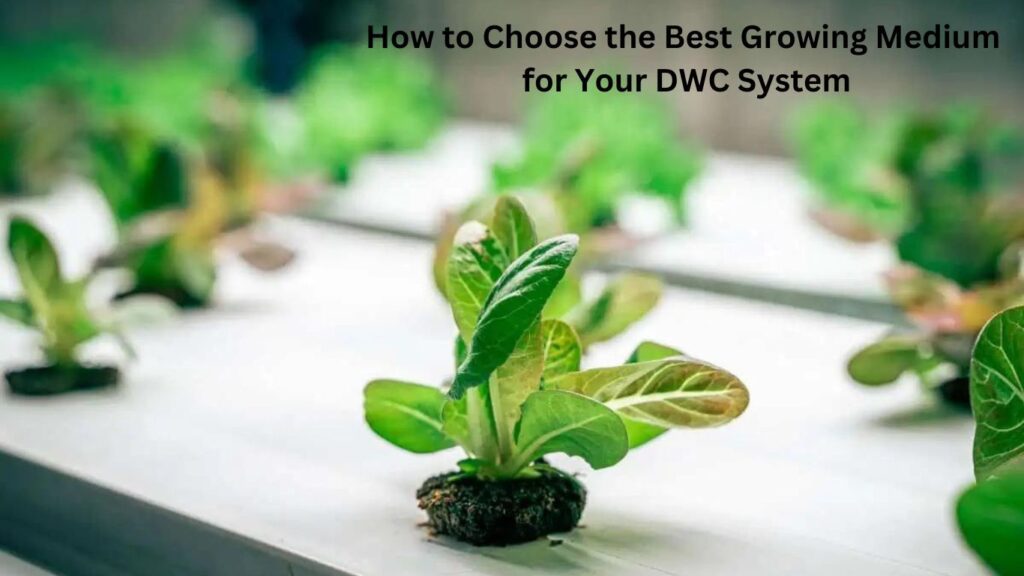
When selecting a growing medium for your DWC system, it is crucial to consider the sterility and disease resistance of different options. The health of your plants depends on the cleanliness and disease-free environment provided by the growing medium.
Sterility refers to the absence of microorganisms that can harm plant roots and introduce diseases. It is important to choose a growing medium that has been properly sterilized to minimize the chances of pathogen contamination. Disease resistance, on the other hand, pertains to the ability of the growing medium to suppress the development and spread of plant diseases. Some growing mediums have natural properties that inhibit the growth of harmful pathogens, providing an added layer of protection for your plants.
• Sterility is crucial for the health of plants in a DWC system
• Growing medium should be properly sterilized to minimize pathogen contamination
• Disease resistance refers to the ability of growing medium to suppress plant diseases
• Some growing mediums have natural properties that inhibit the growth of harmful pathogens
10) Weighing the Pros and Cons of Common Growing Mediums: Coco Coir
Coco coir, also known as coconut fiber, has become a popular choice among hydroponic growers as a growing medium for their deep water culture (DWC) systems. One of the main advantages of using coco coir is its excellent water retention properties. This natural fiber can hold up to 10 times its weight in water, ensuring that your plants have a constant supply of moisture even in the driest of conditions. Additionally, coco coir provides good aeration for the roots, allowing them to breathe and preventing root rot.
Another benefit of coco coir is its sustainability. Made from the husk of coconuts, which are a readily available resource, coco coir is a renewable and eco-friendly option for hydroponic gardening. It also has a longer lifespan compared to other growing mediums, so you don’t have to replace it as frequently. However, it’s important to note that coco coir has a high natural salt content, which can affect the nutrient balance in your DWC system. This is why it’s essential to thoroughly rinse and buffer the coco coir before use, to remove any excess salts and create a more suitable environment for your plants.
• Coco coir has excellent water retention properties, holding up to 10 times its weight in water.
• It provides good aeration for the roots, preventing root rot.
• Coco coir is sustainable and eco-friendly as it is made from readily available coconut husks.
• It has a longer lifespan compared to other growing mediums, reducing the frequency of replacements.
• However, coco coir has a high natural salt content that can affect nutrient balance in DWC systems.
• Thoroughly rinsing and buffering coco coir before use is essential to remove excess salts.
11) Weighing the Pros and Cons of Common Growing Mediums: Expanded Clay Pellets
Expanded clay pellets, also known as hydroton or clay pebbles, have gained popularity as a growing medium in hydroponics systems. These lightweight and porous balls offer several advantages for plant growth. One of the major benefits is their excellent drainage properties, allowing for ample oxygenation of the root zone. The porous nature of the pellets helps to prevent waterlogging and provides the roots with access to oxygen, which is vital for healthy plant growth.
In addition to drainage, expanded clay pellets also have a high water retention capacity. This means that they can hold onto moisture to provide a consistent water supply to the roots, even during periods of drought or when the system is not being actively irrigated. This is particularly beneficial in deep water culture (DWC) systems, where the roots are constantly submerged in water. The clay pellets act as a reservoir, holding water and nutrients for the plants to absorb as needed. Overall, expanded clay pellets offer a balanced water holding capacity, ensuring that plants receive adequate hydration without the risk of overwatering.
• Expanded clay pellets have excellent drainage properties, preventing waterlogging and promoting oxygenation of the root zone.
• The porous nature of the pellets allows roots to access oxygen, which is essential for healthy plant growth.
• They have a high water retention capacity, providing a consistent water supply to the roots even during periods of drought or when irrigation is not actively taking place.
• In deep water culture (DWC) systems, where roots are constantly submerged in water, expanded clay pellets act as a reservoir for holding water and nutrients.
• They offer a balanced water holding capacity, ensuring plants receive adequate hydration without the risk of overwatering.
12) Weighing the Pros and Cons of Common Growing Mediums: Rockwool
Rockwool is a popular growing medium used in hydroponic systems due to its unique properties and advantages. One of the main benefits of rockwool is its excellent water retention capabilities. It has a high absorption capacity, allowing it to retain moisture for longer periods, ensuring that the plants have a constant water supply. This property is particularly advantageous for plants that require consistent moisture levels, such as lettuce or herbs. Additionally, rockwool provides good aeration to the roots, preventing the risk of waterlog and promoting healthy root growth.
Another advantage of rockwool is its sterility, which reduces the chances of plant diseases and pests. Rockwool is manufactured in a controlled environment, ensuring that it is free from pathogens and weed seeds. This is especially crucial in hydroponic systems, where plants have limited access to natural soil-based defenses against diseases. Additionally, rockwool is inert and does not contribute any nutrients to the plants. This allows growers to have precise control over the nutrient intake of the plants by carefully adjusting the nutrient solution. However, it is important for growers to note that rockwool requires special handling when disposing of it, as it is not biodegradable and can potentially cause environmental concerns.
• Rockwool has excellent water retention capabilities, ensuring constant moisture for plants
• Provides good aeration to the roots, promoting healthy root growth and preventing waterlog
• Sterile manufacturing process reduces chances of plant diseases and pests
• Inert nature allows precise control over nutrient intake by adjusting the nutrient solution
• Requires special handling when disposing of it due to non-biodegradable nature
13) Weighing the Pros and Cons of Common Growing Mediums: Peat Moss
Peat moss is a popular choice among gardeners as a growing medium for DWC systems due to its excellent water retention properties. It can hold moisture well, providing a consistent and adequate water supply to the plant roots. This promotes healthy growth and reduces the risk of underwatering. Additionally, peat moss has a good pH balance, making it suitable for a wide range of plants.
However, there are some considerations to keep in mind when using peat moss as a growing medium. One drawback is its tendency to compact over time, potentially reducing the aeration levels for the roots. This can hinder oxygen uptake and nutrient absorption, leading to issues like root rot. Regular monitoring and adjustment of the growing medium’s compaction level is crucial in order to maintain optimal oxygenation for the plants. Moreover, peat moss is not a sustainable resource, as its extraction can pose environmental concerns. As an alternative, gardeners may consider using renewable and eco-friendly substitutes like coconut coir or composted bark. These materials exhibit similar water retention properties while reducing environmental impact.
• Peat moss has excellent water retention properties, providing a consistent water supply to plant roots.
• It has a good pH balance, making it suitable for a wide range of plants.
• However, peat moss tends to compact over time, reducing aeration levels for the roots and hindering oxygen uptake and nutrient absorption.
• Regular monitoring and adjustment of compaction levels is necessary to maintain optimal oxygenation for plants.
• Peat moss extraction can pose environmental concerns as it is not a sustainable resource.
• Gardeners may consider using renewable and eco-friendly substitutes like coconut coir or composted bark.
14) Weighing the Pros and Cons of Common Growing Mediums: Perlite
Perlite is a popular choice for growing mediums in deep water culture (DWC) systems due to its unique properties and benefits. This lightweight volcanic rock is porous, allowing for excellent aeration and drainage, which are crucial for the healthy growth of plant roots. Its ability to retain just the right amount of water also makes it suitable for a variety of plants.
One of the main advantages of using perlite as a growing medium is its neutrality in terms of pH. Unlike some other mediums that can be acidic or alkaline, perlite has a neutral pH level, making it easier to maintain the ideal pH range for your plants. In addition, perlite is inert, meaning it does not contain any nutrients. This allows growers to have complete control over the nutrient solution in the DWC system, ensuring optimal nutrition for their plants.
Another benefit of using perlite is its light weight, which makes it easy to handle and manage in the DWC system. Its fluffy texture also promotes root growth by providing ample oxygen to the roots. However, one downside of perlite is that it tends to break down over time, resulting in the formation of fine particles that can clog the system. Regular maintenance, such as rinsing the perlite and removing any debris, is necessary to prevent clogging and to ensure the continuous flow of nutrient solution to the roots.
In conclusion, perlite is a popular and widely used growing medium in DWC systems, thanks to its excellent aeration, drainage, and pH neutrality. While it requires regular maintenance to prevent clogging, its benefits outweigh this drawback, making it a reliable choice for hydroponic gardeners.
• Perlite is a lightweight volcanic rock that is porous, allowing for excellent aeration and drainage in deep water culture (DWC) systems.
• It has the ability to retain just the right amount of water, making it suitable for various types of plants.
• Perlite has a neutral pH level, which makes it easier to maintain the ideal pH range for plant growth.
• It is inert and does not contain any nutrients, giving growers complete control over their nutrient solution.
• The light weight and fluffy texture of perlite make it easy to handle and promote root growth by providing ample oxygen.
• However, one downside is that perlite tends to break down over time, resulting in fine particles that can clog the system.
• Regular maintenance such as rinsing and removing debris is necessary to prevent clogging and ensure continuous nutrient flow.
15) Weighing the Pros and Cons of Common Growing Mediums: Vermiculite
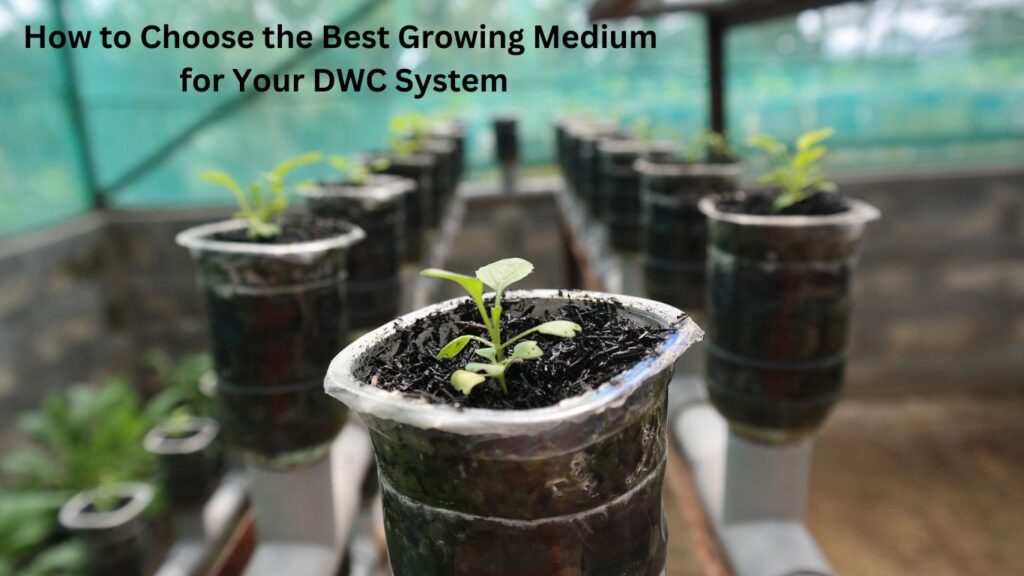
Vermiculite is a common growing medium used in deep water culture systems, known for its unique properties and benefits. One of the main advantages of vermiculite is its exceptional water retention capability. Due to its porous nature, vermiculite can absorb and hold a significant amount of water, ensuring that plant roots have access to moisture consistently. This characteristic is particularly beneficial in hydroponic systems where plants rely on the nutrient solution for their water supply.
In addition to its water-retaining properties, vermiculite also provides good aeration for plant roots. The particles of vermiculite are lightweight and have air pockets, allowing for the exchange of oxygen and carbon dioxide. This helps to oxygenate the root zone and promote healthy root development, which is crucial for optimal plant growth. Furthermore, vermiculite has a neutral pH level, which means it does not significantly affect the acidity or alkalinity of the nutrient solution, providing a stable growing environment for plants.
However, it is important to consider certain drawbacks when using vermiculite as a growing medium. One of the main concerns is its limited nutrient-holding capacity. Unlike other media such as coco coir or rockwool, vermiculite does not have the ability to retain and release nutrients effectively. As a result, it may require more frequent nutrient replenishment to ensure plants receive adequate nutrition. Additionally, vermiculite has a tendency to break down over time, leading to the formation of fine particles that can clog irrigation systems or reduce drainage efficiency. This may require periodic maintenance and monitoring to prevent any potential issues.
• Vermiculite has exceptional water retention capability, ensuring consistent moisture for plant roots.
• It provides good aeration for plant roots due to its lightweight particles and air pockets.
• Vermiculite has a neutral pH level, creating a stable growing environment for plants.
• Limited nutrient-holding capacity may require more frequent nutrient replenishment.
• Over time, vermiculite can break down and form fine particles that may clog irrigation systems or reduce drainage efficiency.
Certainly! Here are two tables outlining considerations for choosing the best growing medium for a Deep Water Culture (DWC) hydroponic system:
Table 1: Growing Medium Characteristics
| Characteristics | Hydroton (Expanded Clay Pebbles) | Coco Coir | Rockwool | Perlite | Oasis Cubes |
|---|---|---|---|---|---|
| Aeration | Excellent | Good | Excellent | Excellent | Good |
| Water Retention | Low | Moderate | Low | Low | Moderate |
| Sterility | Sterile | May contain microorganisms | Sterile | Sterile | Sterile |
| pH Stability | Neutral | May need pH adjustment | May need pH adjustment | Neutral | Neutral |
| Weight | Lightweight | Lightweight | Light to moderate | Very Lightweight | Lightweight |
| Reusable | Yes | Yes | Yes | Yes | Yes |
| Cost | Moderate | Moderate | Moderate | Low to Moderate | Moderate |
| Environmental Impact | Extracted material, but often reusable | Derived from coconut husks | Requires high-temperature manufacturing | Mined material | Derived from foam rubber |
Table 2: Suitability for Different Crops
| Crop Type | Hydroton | Coco Coir | Rockwool | Perlite | Oasis Cubes |
|---|---|---|---|---|---|
| Leafy Greens | Excellent | Good | Excellent | Excellent | Good |
| Fruiting Plants | Excellent | Good to Excellent | Excellent | Excellent | Good to Excellent |
| Herbs | Excellent | Good | Excellent | Excellent | Good to Excellent |
| Root Vegetables | Good to Excellent | Good | Excellent | Excellent | Good |
These tables can help you compare the characteristics of different growing media commonly used in Deep Water Culture systems and assess their suitability for specific crops. Keep in mind that individual preferences, local availability, and budget considerations may also influence your choice of a growing medium for DWC hydroponics.
How to Choose the Best Growing Medium for Your DWC System
When it comes to selecting the right growing medium for your DWC (Deep Water Culture) system, it is important to consider the specific needs of your plants. Different plants have varying nutrient requirements, pH preferences, and water retention capabilities. Additionally, factors such as aeration levels and drainage capabilities are crucial for the overall health and growth of your plants.
One popular growing medium option is coco coir, which is made from the fibrous husk of coconut shells. Coco coir has excellent water retention properties, allowing for efficient nutrient uptake by the plants. It also provides good aeration and drainage, promoting healthy root development. However, it is important to note that coco coir may have a slightly acidic pH, which might not be suitable for all plant varieties.
Another common choice is expanded clay pellets, also known as hydroton. These lightweight and porous pellets provide excellent aeration and drainage, preventing the risk of overwatering and root rot. They also have a neutral pH level, making them suitable for a wide range of plant species. However, expanded clay pellets do not have significant water retention capabilities, and frequent watering may be required to ensure adequate hydration for your plants.
As you explore the suitability of different growing mediums for your DWC system, take into consideration the specific needs of your plants, the characteristics of each medium, and the overall conditions of your growing environment. By carefully evaluating these factors, you can make an informed decision that will contribute to the success of your hydroponic gardening endeavors.
• Coco coir is a popular growing medium option for DWC systems.
• Made from the fibrous husk of coconut shells, it has excellent water retention properties.
• Coco coir provides good aeration and drainage, promoting healthy root development.
• However, it may have a slightly acidic pH, which might not be suitable for all plant varieties.
• Expanded clay pellets, also known as hydroton, are another common choice for DWC systems.
• These lightweight and porous pellets provide excellent aeration and drainage.
• They have a neutral pH level, making them suitable for a wide range of plant species.
• However, expanded clay pellets do not have significant water retention capabilities.
When selecting the right growing medium for your DWC system:
– Consider the specific nutrient requirements and pH preferences of your plants
– Evaluate the water retention capabilities and drainage characteristics of each medium
– Take into account the overall conditions of your growing environment
By carefully considering these factors when choosing a growing medium for your hydroponic garden, you can ensure optimal growth and health for your plants.
What is the best growing medium for a DWC system?
The best growing medium for a DWC system depends on various factors, such as the specific nutrient needs of your plants, pH requirements, water retention properties, aeration levels, drainage capabilities, and disease resistance. It is important to consider these factors and choose a growing medium that suits your plants’ needs.
Can I use organic growing mediums in a DWC system?
Yes, organic growing mediums can be used in a DWC system. However, it is important to assess the suitability of organic growing mediums based on their nutrient content, pH requirements, water retention properties, aeration levels, drainage capabilities, sterility, and disease resistance.
What are the advantages and disadvantages of using coco coir as a growing medium in a DWC system?
Coco coir is a popular growing medium for DWC systems. It has excellent water retention properties, provides good aeration, and is environmentally friendly. However, it may require additional nutrients and pH adjustment, and it can break down and become compact over time.
Are expanded clay pellets suitable for a DWC system?
Expanded clay pellets are commonly used in DWC systems. They provide good aeration, drainage, and are reusable. However, they can be heavy and may require pre-soaking to prevent them from floating.
What are the pros and cons of using rockwool as a growing medium in a DWC system?
Rockwool is a versatile growing medium that provides good aeration and water retention. It is sterile and resistant to diseases. However, it can be expensive, may require pre-soaking, and can cause pH fluctuations.
Is peat moss a suitable growing medium for a DWC system?
Peat moss can be used as a growing medium in a DWC system. It has good water retention properties, is lightweight, and is relatively inexpensive. However, it can become compact and affect water circulation, and it may have sustainability concerns.
What are the advantages and disadvantages of using perlite in a DWC system?
Perlite is a lightweight and sterile growing medium that provides good aeration and drainage. It is affordable and can improve root oxygenation. However, it does not retain water well and may require more frequent watering.
Can vermiculite be used as a growing medium in a DWC system?
Vermiculite can be used as a growing medium in a DWC system. It has good water retention properties and provides insulation for the roots. However, it may compact over time and affect water circulation, and it can be prone to mold growth.
How can I ensure the sterility and disease resistance of my chosen growing medium?
To ensure the sterility and disease resistance of your chosen growing medium, you can consider using sterilized or pre-treated mediums. Additionally, proper hygiene practices, such as maintaining clean equipment and preventing cross-contamination, can help minimize the risk of diseases in your DWC system.

